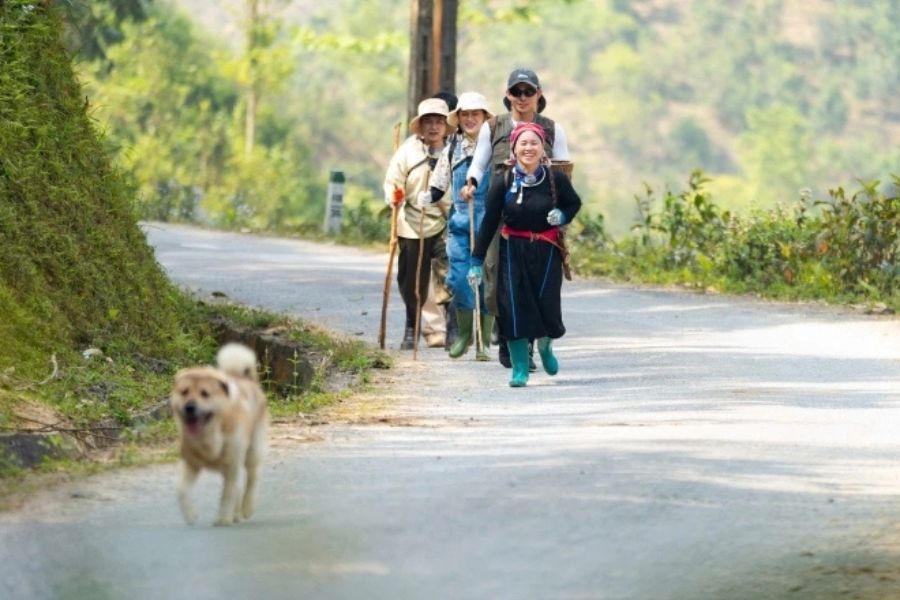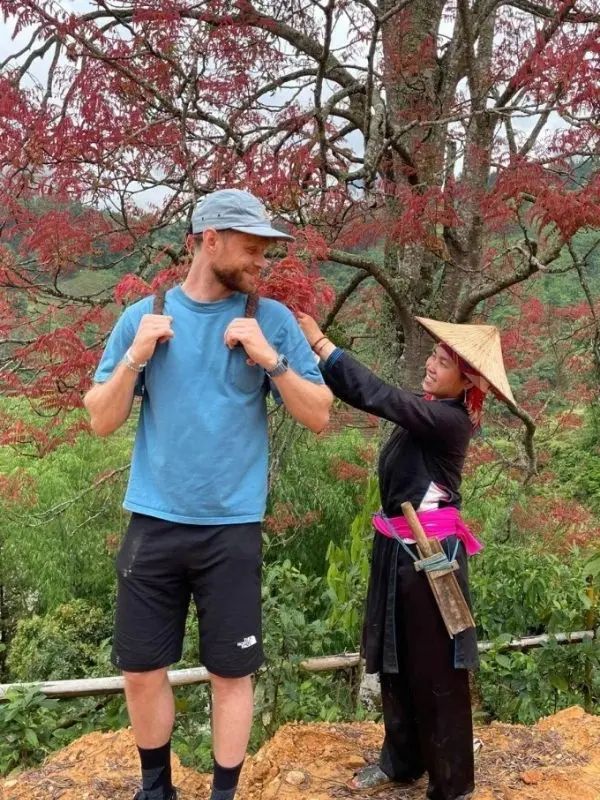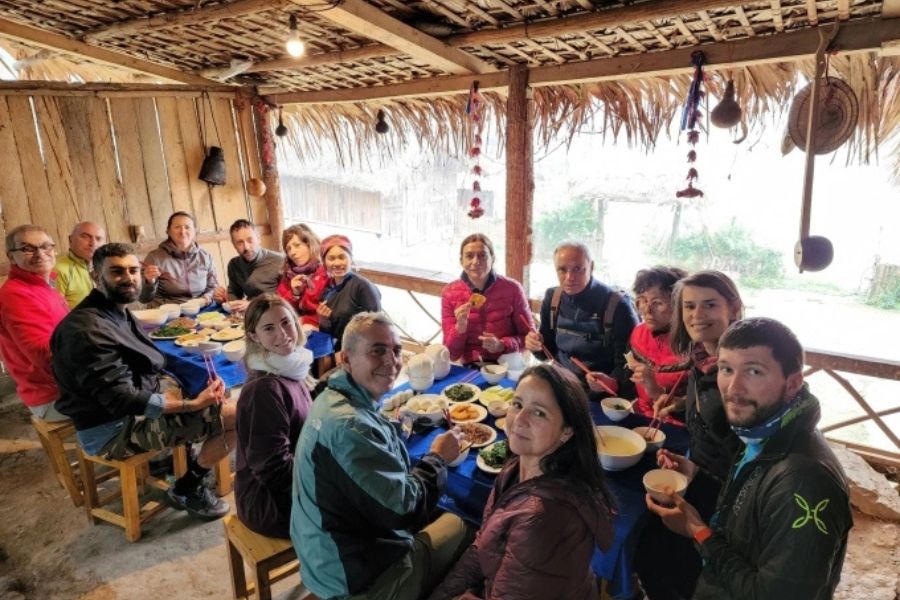If you’ve ever wished your travels could feel like stepping into someone else’s daily life rather than visiting a spectacle, then sustainable travel in Vietnam may be exactly what you’re seeking. Here’s a story that brings it to life—an invitation, really—to join in rhythm with a real Vietnamese family.
A Life in Rice & Guests: Discovering Miss Thông’s Daily World
In Bắc Hà’s Bản Liền commune, nestled among emerald terraces in Lào Cai, lives miss Thông—a Tày woman whose simple decision six years ago would transform her rice fields into a sanctuary for guests seeking authenticity.
Rather than turning her land into commercial crop plots, miss Thông welcomed visitors into her world. And there’s one quote that sums it up: “80% of guests follow the family’s daily schedule—they eat what the family eats, do what the family does.” They rise before dawn, walk barefoot into misty paddies, share meals built from family-grown produce, and join evening stories by the hearth.
While I couldn’t verify the exact phrasing online, local homestay research confirms this type of immersive behavior is typical. So many guests prefer the authentic pace, natural meals, and communal routines—they aren’t staying in a staged attraction—they’re living with miss Thông’s family.
A Day with the Tày Family: From Sunrise to Stilt-House Stories
Here’s what a day might look like:
Dawn: Guests walk rice terraces in ankle-deep water beside miss Thông, transplanting seedlings or harvesting with her family. Villagers sing planting songs in Tày language as ritual.
Midday: The meal is sticky rice, mountain herbs, bamboo shoots, and chicken cooked over fire, shared at a single low table. There’s tea made from wild herbs. Conversation flows—neighbors, multi-generational stories, folklore. Guests don’t just eat; they share and learn.
Miss Thông shows foreign tourists how to carry a traditional basket on their back
Afternoon: Farm chores continue or guests try local craft – basket weaving, catching fish, or garden weaving. The pace is dictated by the family’s natural rhythm, where tourists literally follow the family.
Foreign tourists experience fish catching in Bản Liền village
Evening: A communal dinner under stilt-house rafters. Women might break into Then singing or bowl dances. Everyone participates. Guests sleep in raised wooden houses with woven mats and bamboo chests- no luxury, but tranquility.
Foreign guests enjoy a traditional home-cooked meal with Miss Thông’s family
To many, this is the soul of sustainable travel in Vietnam—a style of travel that engages, respects, and supports cultural continuity rather than separating visitors.
Why Sustainable Travel in Vietnam Should Mean Sharing, Not Spectating
Vietnam’s tourism development—especially in Lào Cai—has explicitly focused on green tourism and community-led models. In communes like Ta Chai, Nghĩa Đô, and Bản Liền, local women act as hosts, chefs, and tour guides. Many households converted rice terraces into sustainable tourism villages governed by cooperative standards and ASEAN awards .
What researchers call community-based tourism (CBT) now often transitions into village-based models, involving entire communities in planning, management, and benefit-sharing. These models are more inclusive, equitable, and sustainable than isolated homestays.
Miss Thông’s homestay embodies this shift: guests participate in agriculture, meals, stories, and rituals alongside locals. They share daily routines—not just photo ops—and their presence supports environmental stewardship and community-led hospitality.
The Power of Authentic Routine: Why 80% Do What Locals Do
Anecdotally, local guides note that most visitors prefer aligning their day to the host family’s schedule. They don’t want air-conditioned comfort—they want sticky rice for breakfast, herbal lunch, and to walk barefoot in fields.
It’s not about deprivation—it’s about real connection. “I want to live as they do, even for one day,” said one British guest after participating in the transplant ceremony. Another from Canada called it “the most restful travel I’ve done—not because it was quiet, but because it was genuine.”
This rhythm—moving with nature, eating what’s fresh, sleeping in a stilt house—defines sustainable travel in Vietnam’s highlands.
Blazing Sustainable Tourism Trails: Lao Cai’s Community Focus
Lào Cai province has made deliberate efforts to promote green tourism, emphasizing ecological protection, cultural preservation, and shared prosperity. Popular villages like Bản Liền host traditional Tay architecture, moss-covered stilt houses, tea gardens, and terraced fields preserved in all four seasons. Locals proudly wear traditional outfits daily, speak Tày, host festivals like Long Tong, and conduct rituals in ancestral houses—without staging them purely for tourism. Authorities support clusters of homestays, offer training in ASEAN-standard hospitality, and reward model villages that meet eco and service criteria. Thus, when travelers align with established local values—like following family routines or joining planting rituals—they participate in a sustainable, respectful cultural exchange.
Perfect for the Middle-Aged Explorer Seeking Depth
If you’re a traveler in your 40s or 50s, you know what matters: comfort paired with authenticity, pacing matched to human rhythms, and cultural depth that leaves a lasting impression. A typical Vietnam local tour company can tailor a package that includes Bản Liền and Miss Thông’s homestay—blending cultural immersion, sustainable practices, and local-led travel. Guests stay in stilt houses, share meals, harvest rice, enjoy local music, and sleep amidst quiet terraces. Such packages echo the global trend toward slow travel, meaning-focused itineraries, and sustainable engagement. To learn more or book a journey like this, check out our trusted Vietnam local tour company page. They specialize in community-based itineraries, including visits to communities like Bản Liền where sustainable travel in Vietnam is more than a buzzword – it’s living.
Why This Approach Matters
This is not tourism that extracts value – it shares value. By joining in daily life, guests deposit not just money, but empathy. Their presence upholds community dignity and rewards cultural preservation.
It’s a cycle: as demand grows for authentic experience, communities retain cultural practice—not commodify it. Tourists leave transformed; hosts gain economic stability and cultural continuity.
Trust the Daily Pace
If you’ve travelled extensively and now crave not more, but more meaningful, then this is your kind of travel. Sustainable travel in Vietnam is no travel brochure aesthetic—it’s walking barefoot in paddy fields, eating family meals, hearing ancestral tales, wearing traditional attire, and sleeping on wooden floors bathed in moonlight.
Miss Thông and her rice terraces are not staged. They’re real life—on display, yes, but only because the community chose to share it. And when guests say they eat what the family eats and follow the family’s routine—that’s not marketing fluff. It’s how they choose to travel.





